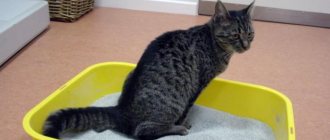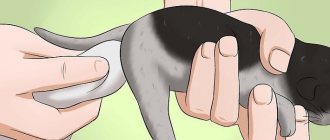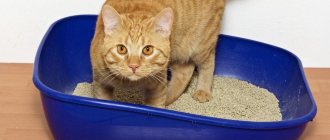Toilet training is a rather painstaking task, so many breeders prefer to give their kittens only after completing this difficult course. But even such exemplary animals can neglect established rules. If your cat starts pooping in the wrong litter box, don’t rush to scold her. There is a high probability that she was not to blame for what happened.
The intricacies of cat litter: what do you need?
It is more natural for a cat to go into a litter tray than to relieve itself in the corners. Peeing and pooping in the sand or soil, then burying your feces and their smell is inherent in it by nature. Only a rare cat is completely unteachable.
IMPORTANT: Cats are clean animals. Typically, humans do not need to toilet train kittens. The mother cat takes this care upon herself.
If the kitten is with its mother for one and a half to two months, the mother regularly goes to the litter box herself, there is a high probability that once the baby finds itself with its new owners, it will very soon go to it. Small errors in the first days can be attributed to the stress experienced by the animal and getting used to the new environment.
A potty with filler and a spatula should appear in the house at the same time as the kitten.
Owners who decide to get a kitten, in turn, need to prepare for its appearance in the house by acquiring a “cat dowry”:
- Buy a tray. You may have to buy several trays at once. If the apartment or house is large, it is good to place them in every room, at least for the first time. Then the toilet will always be in sight of the kitten, reducing the risk that the baby will not reach it if necessary.
- Buy filler for the tray. For a kitten, it is better to take the one that is odorless. Odorous ones may neutralize the “amber” of cat urine. But! Firstly, pungent odors can scare away the animal, and it organizes a toilet for itself in the most unusual and inappropriate place. Secondly, the kitten may be allergic to the fragrance. Alternatively, you can use sand instead of filler. But where is the guarantee that it is clean? And sand does not retain odors. Also, sometimes scraps of newspapers are placed in the kitten's tray. But the paint on them can be toxic, so if you use paper, it’s better to use the simplest toilet paper.
- Buy a mat for the tray. Then there will be no traces of wet paws on the floor, and the smell will not spread throughout the apartment.
- Buy a spatula for the tray. They are sold in pet stores, but an ordinary children's sand scoop will also work.
IMPORTANT: In order for a kitten to start going to the litter box, it is important not only to choose it correctly, but also to place it in the right place
Usually, a kitten is potty trained by its mother cat.
Often owners are concerned about problems of smell and aesthetics, and they hide the tray in the apartment, for example, in the toilet. But at first the animal may not have time to reach him. The tray should be positioned so that it is accessible to the kitten, but so that no one scares the baby away during the toilet.
It is better to choose a secluded corner for him. If later you want to hide the pot, you need to do this gradually, moving it little by little every day to its destination.
IMPORTANT: The cat's potty should be as far away from his dishes as possible.
If the kitten is from a clean cat, its owner guarantees that it is toilet trained; often it is enough to show the baby his new potty a couple of times for him to start using it regularly. But there are situations when the kitten doesn’t even see the tray, peeing and pooping anywhere but in it. Then the owners have to try to correct the situation.
The cat is stressed
Considering that apartment whiskered-striped cats have a very negative attitude towards any changes in the home and family composition, stress may be the reason for changes in established behavioral stereotypes. When experiencing emotional stress, a cat may forget about the litter box and make a puddle in the wrong place, for example, in the middle of the carpet in the living room or right in the owner’s bed. And this will not be a conscious insidious action or an expression of a negative attitude towards a person - the body is simply out of alignment at the moment, and past conditioned reflexes do not work.
Causes of stress. The following events can plunge a sensitive mug into stress:
- a noisy family holiday and a big cheerful company;
- global renovation;
- change in conditions of detention, place of residence and/or owner;
- unusual diet;
- tedious journey;
- washing, cutting out mats, trimming nails and other care activities;
- injections, IVs, wound treatment and similar medical procedures;
- the appearance of a new pet in the apartment;
- serious fight with an opponent;
- boredom and loneliness.
Having identified a possible stress factor, it is necessary to protect the animal from it in order to normalize the psychological state.
Also watch the video why the cat stopped going to the litter box:
How to potty train a 3 month old kitten? How long does it take to train?
The kitten needs a low pot so that he can climb into it without difficulty.
Until the age of five months, the kitten goes to the toilet frequently. If he is not litter box trained, a serious problem arises. The owners reproach him for being unclean and may begin to think about how to get rid of the animal. But most likely, everything will be fixed!
- You need to compare a 3 month old kitten with a human child and try to put him on the potty. It is necessary to develop a “feeding-toilet” ritual for the baby. The kitten has eaten, drank some water, and should be taken to the potty! A full stomach and bladder should do the trick.
- It is necessary to place the kitten on the tray after each sleep.
- The baby will need to be monitored. If he suddenly stops playing, sniffs, and starts “digging,” he should be moved to the potty. This should not be done abruptly, without screaming, so that the kitten does not get scared.
- A common mistake is to pick up a kitten's paw and make digging movements with it. From such violent manipulation the animal will become confused, frightened and unlikely to understand what is required of it. The best option is to take on the mother cat's job, sit next to the cat potty and scoop the litter with your palm.
- If the kitten ignores the litter box and relieves itself in the same place, it may be necessary to permanently or temporarily move the litter box there. Often such a place is the corner behind the door, the space behind the chair or behind the sofa, secluded, quiet, where the baby feels safe.
- Another option is to limit the kitten’s “habitat” so that it does not have access to the places where it organizes its toilet. But there should be no talk of locking it in the toilet or on the balcony. If a kitten makes a puddle, there is no point in poking his nose into it. He will not draw useful conclusions for himself, but he may begin to take revenge.
IMPORTANT: Places where a 3-month-old kitten goes to the toilet must be thoroughly washed so that they do not retain the smell of his feces.
If a 3-month-old kitten does not get used to going to the litter box, its habitat needs to be limited for a while.
You can read about how to remove the acrid smell of cat urine here:
The kitten is potty trained immediately, within a couple of days or until it grows up. If he went where he needed to go one, two or three times, this is not yet a system. The baby will need to be monitored for a few more days to consolidate the results.
Cats are clean pets, so the kitten very quickly learns to use the litter box.
Specific events
How to stop a cat from shitting when it happens in certain places on a regular basis? Several such characteristic places can be identified. Nature directs the animal to pots with home flowers, where it is attracted by the soft soil, and even with the smell of fertilizer. Of course, the easiest way is to put the flowers out of reach of the cat. In cases where this is undesirable, the following methods of influence can be recommended: placing a garlic clove or lemon peels on the soil surface; covering the surface (usually a window sill) on which the pots stand with foil or taping the area near the pot; placement of twigs around the perimeter of the pot, creating an interfering fence (toothpicks can be used). Such inconveniences will wean the animal from unscheduled toileting, and after a while all elements can be removed.
Vinegar will help stop your pet from pooping in the litter box.
On a note! If a cat gets into the habit of shitting on the bed, then measures must be taken as quickly as possible so that such comfortable conditions do not become a habit.
First of all, resolutely block the way to the bedroom by closing the door. Using lavender when rinsing bedding is considered a fairly effective method. You can simply apply a few drops of lavender oil to the top of your bed, especially at the head of your bed. Cats cannot stand the smell of lavender and will give up their intentions.
An animal can shit on the floor in different places in the apartment or run out into the entrance and defecate there. A vinegar solution can be considered an effective remedy. If you treat the floor with it, the cat will not make a toilet there. A positive result is achieved by using ready-made products intended for these purposes and sold in a pet store: Nature's Miracle, Odor-Secret, Nok-Out, Urine-Off. Sometimes the animal takes a liking to a certain corner in the apartment and does “its business” there. In this case, it is best to install a tray in this corner.
Nature's Miracle gives positive results
Finally, there is also a known radical way to stop a cat from crapping. The animal is locked in a small room (for example, a bathroom), where a tray is installed and a bowl of water is placed at a distance. To feed, the cat is taken to a bowl of food 2-3 times a day. The rest of the time she remains locked up and is forced to use the litter box. The cessation of isolation should be carried out gradually, as the animal gets used to the tray.
The question of how to wean a cat from shitting in the wrong place at home should be decided taking into account the reasons leading to this behavior of the animal. First of all, it is necessary to eliminate these causes and ensure maximum peace of mind for the cat. In the presence of diseases, the intervention of a veterinarian is necessary, but in other cases, a kind attitude towards your pet and patience will help.
How to potty train an adult cat quickly?
If you took home not a small kitten, but an adult cat from the street or from a shelter, perhaps she is already potty trained, she will only need some time to adapt. If a street animal has been going to the toilet anywhere all its life, you will have to tinker.
In principle, the algorithm is the same as with a small kitten:
- place several pots around the house
- show the animal why they are needed
- put the cat on the potty after sleep, after eating, when she starts digging and paving
A cat, like a small child, sometimes has to be put out on the potty.
IMPORTANT: If the cat lived on the street, at first it is better to pour ordinary sand into its tray instead of litter. The pet will get used to it faster
If your cat persistently pees where it shouldn’t, it is recommended to soak a piece of cloth or cotton wool in its urine and place it in the tray to transfer the smell there. Wash the crime scene itself thoroughly.
How to understand why a cat shits everywhere?
Before you begin to study ways to overcome a nasty habit, it is necessary to analyze the reasons for inappropriate behavior. Without a clear understanding of your motives, you will not be able to achieve a positive result. All the efforts of the owners will be in vain, and relationships in the house will go wrong.
There is a fairly impressive list of reasons why a cat began to shit anywhere. Each animal is different, so owners may have to work hard to solve the problem.
So, you noticed that the cat began to shit everywhere. What to do in this case? Let's figure it out.
How to potty train a cat without litter?
Like its distant African ancestors, the domestic cat loves to go to the toilet on something soft, then bury the feces. It wouldn't be surprising if an unfilled pot with a rough plastic lattice might deter him. But you can still teach him to relieve himself in this way by gradually reducing the amount of sand poured into the tray.
It's a cat's instinct to scoop up its own feces.
Another thing is that the smell of urine will spread throughout the house.
Tray training a kitten
You need to start raising a pet from a young age .
He will need a special tray that needs to be kept clean. The filler should be selected taking into account the age of the animal, as well as the length of its fur. When the baby appears in the house, it is worth keeping track of where he goes to the toilet for the first time. You can’t scold him for such an act , you just need to wash the floor thoroughly and remove any manifestations of a specific smell.
A tray is installed in this place, into which the kitten can climb without problems. The next time the animal looks for a secluded place, worry, you need to carefully move it to the tray .
It is important to talk to him gently, calm him down, and sit him on the filler. Special sprays can help with such training . If you find time and patience, you won’t need to stop your kitten from crapping in your living room or on your bed.
ATTENTION! During the first days of training, you will need to endure an unpleasant odor from the tray; it is not recommended to wash it during this period. The kitten will find its toilet faster by smell.
The cat pees past the potty: what to do?
It happens that a cat runs to the tray, but sits on the edge or raises the back of its body high, so it relieves itself past, on the floor near the potty. The reasons for this behavior may be the following:
- the cat has health problems (for example, arthritis, it hurts to sit down)
- the filler in the tray is dirty, it has not been changed for a long time
- the tray is too small for the animal
The cat may walk past the litter box if it is too small.
You can deal with this situation:
- Have the animal examined by a veterinarian.
- Maintain tray hygiene.
- Buy a more spacious tray, with high sides, or a house tray.
- Place an absorbent disposable diaper under the tray.
The cat does not go to the toilet at all - reasons and solutions
Complete refusal mainly has medical reasons. But behavioral factors also influence the problem. Under severe stress (for example, moving), the animal may not completely defecate for two days.
Be sure to read:
How many times a day should a cat pee: the norm for an adult animal and kittens, when deviations are safe
In the absence of health problems, sooner or later this will happen. If not, this is a signal of serious violations.
Why does a cat refuse to walk small?
If the animal does not go to the toilet at all, you need to look for medical reasons. At the same time, the pet's behavior changes.
If the cat does not go to the toilet at all, you need to look for medical reasons
Vanity, uncertainty, and causeless meowing appear. There is pain in the area where the bladder is located.
Causes:
- Drinking a small amount of water is the culprit in the formation of stones and insufficient urine output.
- Excessive consumption of meat and fish provokes problems with urine output. A large amount of protein in the diet causes edema and fluid retention.
- A neutered adult pet does not walk much due to high weight, lack of activity, and movement.
- A problem that requires an immediate visit to the veterinarian is a congenital anomaly of the urinary system.
- Often, eating dry food causes the problem. You need to give more fluid.
- Provokes refusal to use the toilet or rare urination: cystitis, kidney inflammation, urolithiasis, sand in the urine.
In a big way
Normally, an adult pet should go to the toilet more than once a day. Minor deviations are allowed. If the cat does not defecate for more than 4 days, you need to contact a veterinarian.
Normally, an adult pet should go to the toilet more than once a day.
What are the reasons:
- The most common factor in stool retention is poor nutrition, lack of normal amounts of fiber, fluid, and bones.
- The cat refuses to go to the toilet due to a sudden change in the situation, the presence of strangers, or pets.
- A large amount of fur in the pet's stomach. Cats lick the fur with their tongue, it remains in lumps in the body. With proper nutrition, the leftovers come out on time, without clumping into large lumps. For this purpose, animals eat grass.
- Insufficient activity leads to infrequent bowel movements.
- As cats age, their gastrointestinal tract works slowly and intermittently.
- Diseases of the intestines and other nearby organs.
Why did the cat stop going to the litter box?
If a cat successfully went to the litter box and then began to shit, most likely she has extreme reasons for this. Contrary to popular belief, they rarely take revenge in this way.
A cat rarely shits out of revenge. Usually, she has more compelling reasons for this.
- The cat's potty is not clean enough. It must be cleaned regularly. After each trip to the toilet, remove the crumpled litter with a spatula and periodically replace the entire contents of the tray.
- The tray is washed too thoroughly. A cat may refuse to go potty after being washed with bleach or another strong-smelling detergent.
- Incorrect filler selected. You may have to try several types to find one that your cat likes. It is not advisable to change the brand of filler. If there is no way out, you need to do this gradually, mixing a small amount of new sand with the old.
- Another cat has already gone into the litter box if there are several of them in the house. For “cat people” there is a rule: the number of pots is the number of animals in the house plus one more spare.
- The potty is too close to the cat food. A clean animal will not relieve itself where it eats.
- Someone scared the cat on the potty, now he relieves himself in secluded places. You should think about buying a potty house where no one will see the cat in action.
- The cat has a disease of the urinary system. Only a veterinarian can help here.
- Due to old age or illness, the cat cannot reach the potty. It should be moved closer to the place where the helpless animal has settled. The tray should be low. Again, it is necessary to make a visit to the veterinary clinic.
- The cat is stressed. Yes, yes, a pet can experience it if they are treated poorly, if the owners quarrel among themselves, if there are often strangers in the house, if the family has moved to a new home, if they have another animal, etc., etc. Affection, sedatives prescribed by a veterinarian, and the time needed to adapt will help.
- The cat marks. Most often, adult, uncastrated cats mark their territory. Raising their tail, they direct the stream at vertical surfaces, leaving foul-smelling spots on them. Most likely, somewhere nearby there is an animal - a potential rival or a potential “bride”.
The cat stops going to the litter box if he doesn't like the smell of the litter.
Physiological reasons
This group includes hormonal changes, pathologies and instincts. Only diseases of the urinary system pose a real danger, so it is very important to make sure that they are absent.
Sexual heat or hormonal imbalance
During sexual hunting, males actively mark their territory, scaring off competitors and attracting females. This period is easy to track by frequent serenades, unusual aggression and the pungent smell of urine.
Kitties can also mark their territory during heat or pregnancy. In the second case, this instinct is aimed at scaring away potential enemies who could harm unborn kittens.
It is important here to exclude false pregnancy. Despite the similar symptoms, such a hormonal imbalance can result in mastitis and other dangerous complications.
Diseases of the urinary system
A cat may urinate in the wrong place due to frequent urges or severe pain. In the first case, she simply does not have time to reach the toilet, and in the second, she tries to find more secluded corners in the hope of getting rid of the unpleasant sensations.
Common diseases of the genitourinary system include:
- Cystitis
. The most common cause of bladder inflammation is bacterial infection. Accompanied by frequent urination, acute pain and a gradual reduction in the amount of urine passed to a couple of drops. - Urolithiasis (UCD)
. It develops when the ureter is blocked by large stones. A sick cat urinates blood, as the sharp edges of the stones injure the mucous membranes. - Urethritis
. It occurs as a complication of cystitis or urolithiasis and affects the urethra. The main signs of this disease are the presence of purulent impurities in the urine and an ammonia or acetone odor of the skin. - Atony of the bladder
. Characteristic of older animals experiencing degenerative changes in organs and tissues. Their muscles lose their strength and elasticity, so the bladder ceases to cope with its main function - holding urine. It begins to leak, and the pet simply does not have time to get to the toilet in time.
If you notice alarming symptoms, be sure to contact your veterinarian. Timely treatment will help avoid complications and speed up the recovery process.
Defending territory
When a new pet appears, the instinct of possessiveness often awakens in the “old-timers”. By marking corners, they demonstrate their superiority, wiping the noses of their four-legged competitors.
A cat shits in a flower pot: what to do?
The cat can choose a flower pot as a toilet.
Cats are famous for the fact that they can rake soil out of flower pots or, even worse, shit in them. Here are the tricks of “cat people” that help wean fluffies from such bad habits:
- isolate pots of flowers (especially poisonous ones) from the cat
- put dry citrus skins in flower pots, cats don’t like their smell
- cover the soil in pots with foil, plastic wrap, thin plastic trays, etc.











